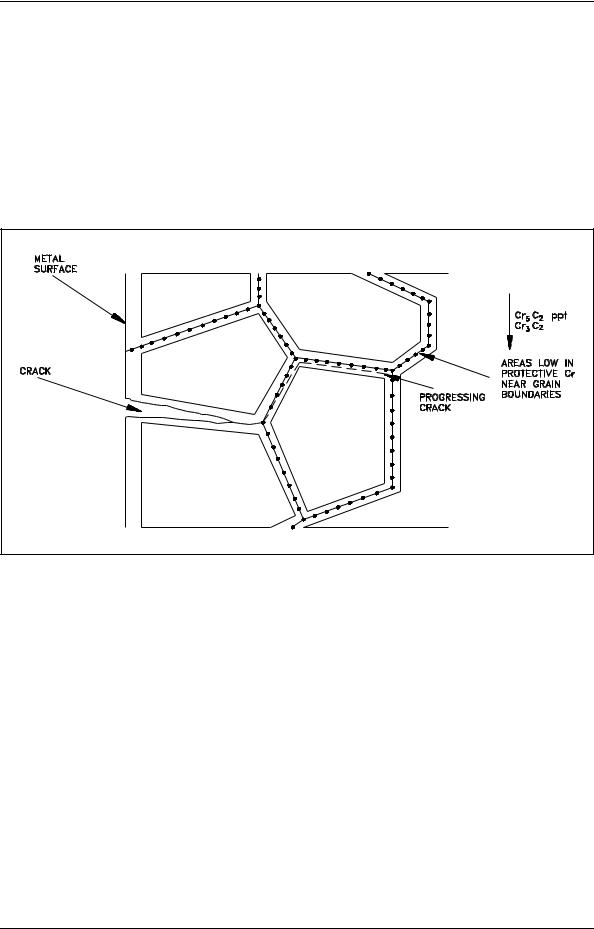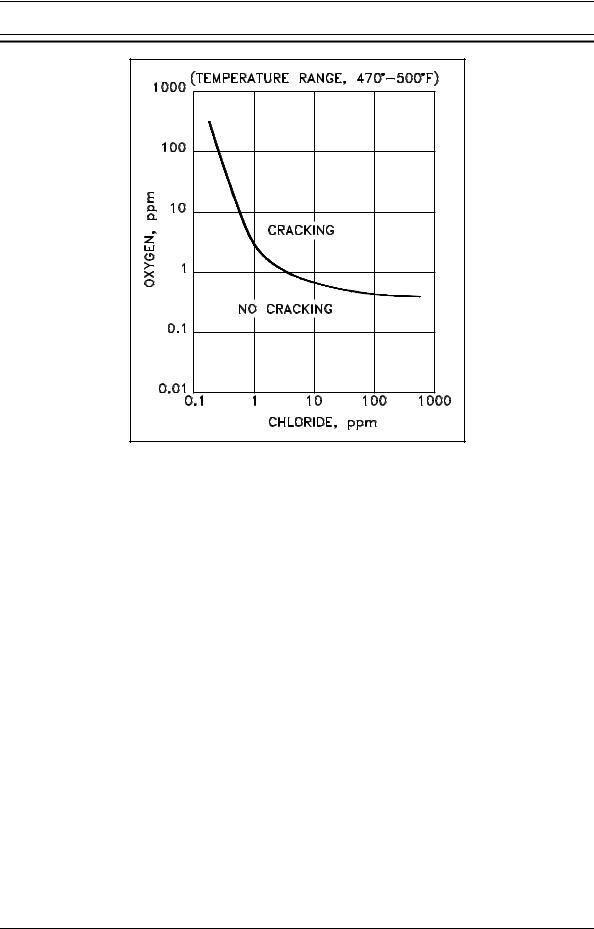
- •ABSTRACT
- •FOREWORD
- •OVERVIEW
- •TABLE OF CONTENTS
- •LIST OF FIGURES
- •LIST OF TABLES
- •REFERENCES
- •OBJECTIVES
- •CHARACTERISTICS OF ATOMS
- •Characteristics of Matter
- •The Atom Structure
- •Chemical Elements
- •Molecules
- •Avogadro's Number
- •The Mole
- •Mole of Molecules
- •Summary
- •THE PERIODIC TABLE
- •Periodic Table
- •Classes of the Periodic Table
- •Group Characteristics
- •Atomic Structure of Electrons
- •Summary
- •CHEMICAL BONDING
- •Chemical Bonding
- •Ionic Bonds
- •Covalent Bonds
- •Metallic Bonds
- •Van der Waals Forces
- •Organic Chemistry
- •Alkanes
- •Alkenes
- •Alkynes
- •Aromatics
- •Alcohols
- •Aldehydes
- •Basic Chemical Laws
- •Forming Chemical Compounds
- •Combining Elements
- •Summary
- •CHEMICAL EQUATIONS
- •Le Chatelier's Principle
- •Density
- •Molarity
- •Normality
- •Parts per Million
- •Chemical Equations
- •Balancing Chemical Equations
- •Summary
- •ACIDS, BASES, SALTS, AND pH
- •Acids
- •Bases
- •Salts
- •Dissociation Constant
- •Summary
- •Introduction
- •Isotopic Separation
- •Separation Factor
- •Stage Separation
- •Barrier Measurements
- •Cascade Theory
- •Circuit Balances
- •CONVERTERS
- •Converters
- •Converter Construction
- •The Gas Cooler
- •Barrier Tubing
- •Process Gas Flow
- •Diffusion
- •TABLE OF CONTENTS
- •LIST OF FIGURES
- •LIST OF TABLES
- •REFERENCES
- •OBJECTIVES
- •CORROSION THEORY
- •Corrosion
- •Electrochemical Cells
- •Oxidation-Reduction Reactions
- •Passivity and Polarization of Metal
- •Summary
- •GENERAL CORROSION
- •Conditions Contributing to General Corrosion
- •Corrosion of Iron
- •Factors Affecting General Corrosion Rate
- •Prevention Chemistry Control
- •Corrosion of Aluminum
- •Summary
- •CRUD AND GALVANIC CORROSION
- •Crud
- •Galvanic Corrosion
- •Prevention of Galvanic Corrosion
- •Summary
- •SPECIALIZED CORROSION
- •Pitting and Crevice Corrosion
- •Stress Corrosion Cracking
- •Summary

Corrosion |
DOE-HDBK-1015/1-93 |
SPECIALIZED CORROSION |
|
|
|
Pitting and crevice corrosion are a major hazard to a nuclear facility because of the rapid penetration of the metal with little overall loss of mass. A nuclear facility minimizes pitting and crevice corrosion by the following actions.
&Avoiding stagnant or low flow conditions.
&Using metals and alloys that are less susceptible to the corrosion.
&Avoiding agents in the medium that cause pitting (for example, chlorides and oxygen).
&Designing the system and components such that no crevices are present.
Stress Corrosion Cracking
Stress corrosion cracking (SCC) is a type of intergranular attack corrosion that occurs at the grain boundaries under tensile stress. Grain boundaries are discussed in detail in the Material Science Handbook. SCC occurs in susceptible alloys when the alloy is exposed to a particular, specific environment if the alloy is in a stressed condition. Stress corrosion cracking appears to be relatively independent of general uniform corrosion processes. Thus, the extent of general corrosion can be essentially nil, and stress cracking can still occur. Most pure metals are immune to this type of attack.
According to the most widely accepted theory, stress corrosion cracking is caused by a process called chemisorption. Unlike relatively weak physical absorption, such as hydrogen gas on platinum metal, chemisorption may be thought of as the formation of a compound between the metal atoms on the surface as a monomolecular layer of the chemisorbed substance, such as Cl-, OH-, Br-, and some other ions. The formation of this chemisorbed layer greatly reduces the attraction between neighboring metal atoms. A defect initially present then grows as the metal atoms separate under stress, more chemisorption occurs, and the process continues. In very severe cases, the time required for this cracking to occur is only a matter of minutes.
Many stainless steels are susceptible to stress corrosion cracking. Stainless steels containing 18 percent chromium and 8 percent nickel are susceptible to cracking in environments containing chloride ions and in concentrated caustic environments (that is, in environments where the hydroxyl ion concentration is high). On the other hand, these types of stainless steels do not exhibit any tendency to crack when they are exposed to water environments containing nitrate (NO3-), sulfite (SO3--), and ammonium (NH3+) ions.
SCC is of great concern because it can readily crack metal of appreciable thickness. If the environment is severe enough, cracking can occur in a very short period of time. The crack can then lead to a serious failure of the component, or the system, and all the attendant results (for example, contamination, loss of coolant, and loss of pressure).
Rev. 0 |
Page 31 |
CH-02 |

SPECIALIZED CORROSION |
DOE-HDBK-1015/1-93 |
Corrosion |
|
|
|
The most effective means for preventing SCC are proper design, reducing stress, removing critical environmental contributors (for example, hydroxides, chlorides, and oxygen), and avoiding stagnant areas and crevices in heat exchangers where chlorides and hydroxides might become concentrated. Low alloy steels are less susceptible than high alloy steels, but they are subject to SCC in water containing chloride ions. Nickel based alloys are not affected by chloride or hydroxide ions.
Two types of SCC are of major concern to a nuclear facility.
Chloride Stress Corrosion Cracking (Stainless Steels)
The three conditions that must be present for chloride stress corrosion to occur are as follows.
&Chloride ions are present in the environment
&Dissolved oxygen is present in the environment
&Metal is under tensile stress
Austenitic stainless steel is a non-magnetic alloy consisting of iron, chromium, and nickel, with a low carbon content. This alloy is highly corrosion resistant and has desirable mechanical properties. One type of corrosion which can attack austenitic stainless steel is chloride stress corrosion. Chloride stress corrosion is a type of intergranular corrosion.
Chloride stress corrosion involves selective attack of the metal along grain boundaries. In the formation of the steel, a chromium-rich carbide precipitates at the grain boundaries leaving these areas low in protective chromium, and thereby, susceptible to attack. It has been found that this is closely associated with certain heat treatments resulting from welding. This can be minimized considerably by proper annealing processes.
This form of corrosion is controlled by maintaining low chloride ion and oxygen content in the environment and the use of low carbon steels. Environments containing dissolved oxygen and chloride ions can readily be created in auxiliary water systems. Chloride ions can enter these systems via leaks in condensers or at other locations where auxiliary systems associated with the nuclear facility are cooled by unpurified cooling water. Dissolved oxygen can readily enter these systems with feed and makeup water. Thus, chloride stress corrosion cracking is of concern, and controls must be used to prevent its occurrence.
CH-02 |
Page 32 |
Rev. 0 |

Corrosion |
DOE-HDBK-1015/1-93 |
SPECIALIZED CORROSION |
|
|
|
Figure 14 illustrates intergranular stress corrosion cracking. The pressure of a tensile stress opens up intergranular cracks and accelerates further corrosion. Chloride stress corrosion is a particularly significant problem in the operation of nuclear facilities because of the wide use of austenitic stainless steel, and the inherent presence of high tensile stresses associated with pressurization. Chloride stress corrosion cracks have been known to propagate in austenitic stainless steel at stresses of about one-fifth yield strength with chloride concentrations of less than 50 ppm. Yield strength is discussed in detail in the Material Science Handbook.
Figure 14 Intergranular Corrosion Cracking
Tests show that the 18-8 stainless steels are susceptible to chloride stress attack when both the chloride ion concentration and dissolved oxygen concentration are above certain values. The region of susceptibility for austenitic stainless steel is illustrated in Figure 15. Note that when dissolved oxygen is present at about 1 ppm, chloride stress corrosion cracking can be initiated at chloride ion concentrations near 1 ppm. However, when the concentration of dissolved oxygen is very low, susceptibility to chloride stress corrosion cracking is reduced.
High temperature tends to decrease the time required for chloride-induced cracking to occur, but there appears to be no practical temperature limit below which cracking will not occur, given sufficient time and severe conditions. The curve in Figure 15 is valid for temperatures in the range 470(F to 500(F.
Rev. 0 |
Page 33 |
CH-02 |

SPECIALIZED CORROSION |
DOE-HDBK-1015/1-93 |
Corrosion |
|
Figure 15 Austenitic Stainless Steel |
|
Caustic Stress Corrosion Cracking
Caustic stress corrosion, or caustic embrittlement, is another form of intergranular corrosion cracking. The mechanism is similar to that of chloride stress corrosion. Mild steels (steels with low carbon and low alloy content) and stainless steels will crack if they are exposed to concentrated caustic (high pH) environments with the metal under a tensile stress. In stress cracking that is induced by a caustic environment, the presence of dissolved oxygen is not necessary for the cracking to occur.
Caustic stress corrosion cracking was first encountered in the operation of riveted steam boilers. These boilers were found to fail on occasion along riveted seams. Failure was attributed to caustic-induced cracking at the highly stressed regions near and under the rivets. Boiler water could easily flow into the crevices which existed under the rivets.
Radiative heating would cause the water in the crevices to boil. As steam was formed, it would escape from the crevice. More boiler water would then flow into the crevice, boil, and pass from the crevice as steam. The net result of this continuing process was concentration of caustic under the rivet. The combination of high stress and high caustic concentrations eventually led to destructive cracking of the boiler vessel.
CH-02 |
Page 34 |
Rev. 0 |

Corrosion |
DOE-HDBK-1015/1-93 |
SPECIALIZED CORROSION |
|
|
|
Where the rate of steam generation (boiling) is high, it is more difficult to eliminate the problem of solute concentration in regions of the boiler. Caustic stress corrosion may concentrate in such regions as the water evaporates rapidly, but sufficient concentration of caustic by such a mechanism to induce stress cracking is considered unlikely.
Available data indicates that caustic concentrations greater than 10,000 ppm, and probably up to 50,000 ppm, are required to induce caustic stress cracking (40,000 ppm NaOH is equivalent to 40 grams per liter or 1 mole per liter). The pH of such a solution is on the order of 14. An alkaline environment is produced and controlled by use of a solution having some properties of a buffer, that is, one that tends to retard or slow a reaction or tends to force it in one direction or the other.
Rev. 0 |
Page 35 |
CH-02 |
